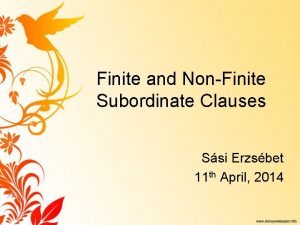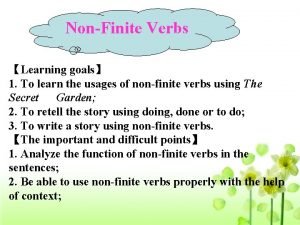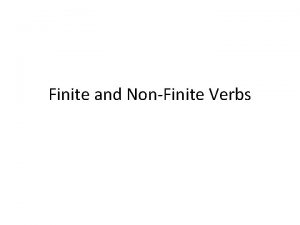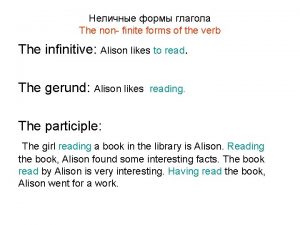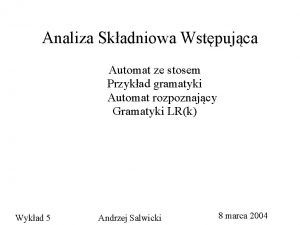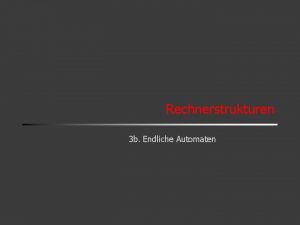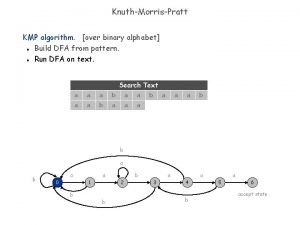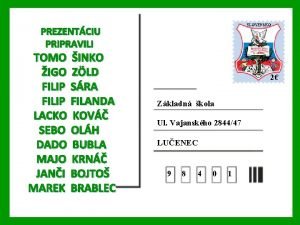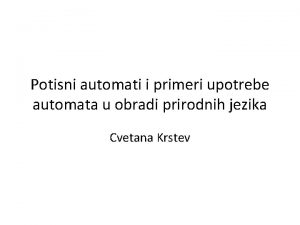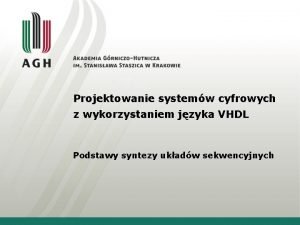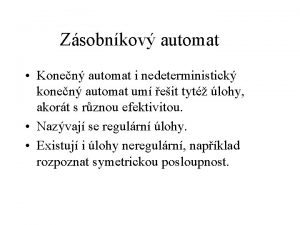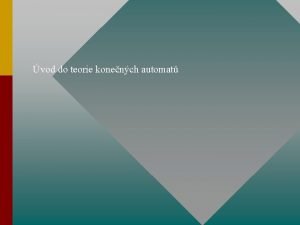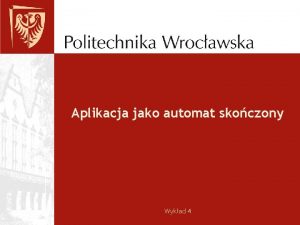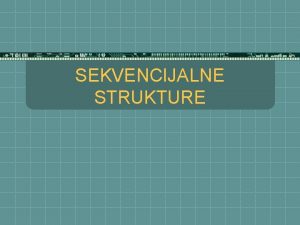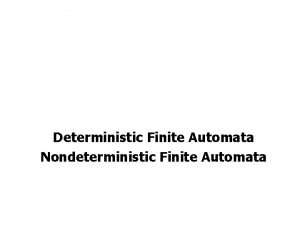IMPLEMENTATION OF FINITE AUTOMAT IN CODE There are
















- Slides: 16

IMPLEMENTATION OF FINITE AUTOMAT IN CODE There are several ways to translate either a DFA or an NFA into code. Consider , again the example of a DFA that accepts identifiers consisting of a letter followed by a sequence of letters and/ or digits in its amended form that includes lookahead and the principal of longest substring. 1

IMPLEMENTATION OF FINITE AUTOMAT IN CODE (cont’d) Letter Start Letter {Other} In_id Digit 2 Finish 2 Return ID

Simulation of the DFA 3 { Starting in state 1} If the next character is a letter then advance the input: { now in state 2} While the next character is a letter or a digit do advance the input { stay in state 2} End while; { go to state 3 without consuming input } Accept Else { Error or other cases } End if;

Constructing Transition Diagrams for Tokens 4 Ø Transition Diagrams (TD) are used to represent the tokens Ø As characters are read, the relevant TDs are used to attempt to match lexeme to a pattern

Ø Each TD has: – – l 5 States : Represented by Circles Actions : Represented by Arrows between states Start State : Beginning of a pattern (Arrowhead) Final State(s) : End of pattern (Concentric Circles) Each TD is Deterministic - No need to choose between 2 different actions !

Example TDs Ø Recognition Of Relational Operators >=: start 0 > 6 = 7 other 8 6 RTN(GE) * RTN(G) We’ve accepted “>” and have read other char that must be unread (means push back into input stream)

Example : All RELOPs start 0 < 1 = 2 return(relop, LE) > 3 return(relop, NE) other = 4 5 * return(relop, LT) return(relop, EQ) > 6 7 = 7 other 8 return(relop, GE) * return(relop, GT)

Example TDs : id id : letter or digit start 9 letter 10 other 11 * return( get_token(), install_id()) 8

Example TDs : Unsigned #s digit start 20 digit * 21 . 22 digit 23 other 24 * return(num, install_num()) digit start 9 25 digit 26 other 27 *

Implementing Transition Diagrams l class Scanner { l char _la; // The lookahead character Token next. Token() { start. Lexeme(); // reset window at start while(true) { switch(_state) { case 0: { _la = get. Char(); if (_la == ‘<’) _state = 1; else if (_la == ‘=’) _state = 5; else if (_la == ‘>’) _state = 6; else failure(state); }break; case 6: { _la = get. Char(); if (_la == ‘=’) _state = 7; else _state = 8; }break; } } } l l l l l l 10 } case 7: { return new Token(GEQUAL); }break; case 8: { push. Back(_la); return new Token(GREATER); }

Implementing Transition Diagrams lexeme_beginning = forward; state = 0; 11 FUNCTIONS USED nextchar(), forward, retract(), install_num(), install_id(), gettoken(), isdigit(), isletter(), recover() token nexttoken() { while(1) { switch (state) { case 0: c = nextchar(); start /* c is lookahead character */ if (c== blank || c==tab || c== newline) { repeat state = 0; until lexeme_beginning++; a “return” occurs /* advance beginning of lexeme */ } else if (c == ‘<‘) state = 1; else if (c == ‘=‘) state = 5; else if (c == ‘>’) state = 6; else state = fail(); break; … /* cases 1 -8 here */ 0 < 1 = 2 > 3 other = 4 * 5 > 6 = 7 other 8 *

Implementing Transition Diagrams, II 25 digit * 25 digit 26 . . . case 25; case 26; case 27; 12 c = nextchar(); 27 advances forward if (isdigit(c)) state = 26; else state = fail(); Case numbers correspond to transition break; diagram states ! c = nextchar(); if (isdigit(c)) state = 26; else state = 27; break; retract(1); lexical_value = install_num(); return ( NUM ); retracts. . . forward other looks at the region lexeme_beginning. . . forward

Implementing Transition Diagrams, III. . . case 9: c = nextchar(); if (isletter(c)) state = 10; else state = fail(); break; case 10; c = nextchar(); if (isletter(c)) state = 10; else if (isdigit(c)) state = 10; else state = 11; break; case 11; retract(1); lexical_value = install_id(); return ( gettoken(lexical_value) ); letter or digit . . . 13 reads token name from ST 9 letter 10 other * 11

When Failures Occur: Init fail() { start = state; forward = lexeme beginning; switch (start) { case 0: start = 9; break; case 9: start = 12; break; case 12: start = 20; break; case 20: start = 25; break; case 25: recover(); break; default: /* lex error */ } return start; } 14 Switch to next transition diagram

What Else Does Lexical Analyzer Do? All Keywords / Reserved words are matched as ids • After the match, the symbol table or a special keyword table is consulted • Keyword table contains string versions of all keywords and associated token values if 15 then 16 begin 17 . . . • When a match is found, the token is returned, along with its symbolic value, i. e. , “then”, 16 • If a match is not found, then it is assumed that an id has been discovered 15

ASSINGMENT Design a nondeterministic finite automata in c++. 16
 Insidan region jh
Insidan region jh Finite and non finite subordinate clauses
Finite and non finite subordinate clauses What is finite verb
What is finite verb Learning objectives for finite and non finite verbs
Learning objectives for finite and non finite verbs Finite and non-finite verb
Finite and non-finite verb Finite and non finite
Finite and non finite Automaty ze stosem
Automaty ze stosem Jk flip flop zustandsdiagramm
Jk flip flop zustandsdiagramm Kmp dfa
Kmp dfa Lučenec
Lučenec Potisni automat
Potisni automat Vhdl podstawy
Vhdl podstawy Busceral
Busceral Hci patterns
Hci patterns Tema there is there are
Tema there is there are What part of speech is open
What part of speech is open There is there are negative form
There is there are negative form

